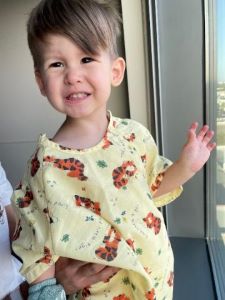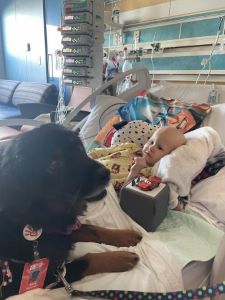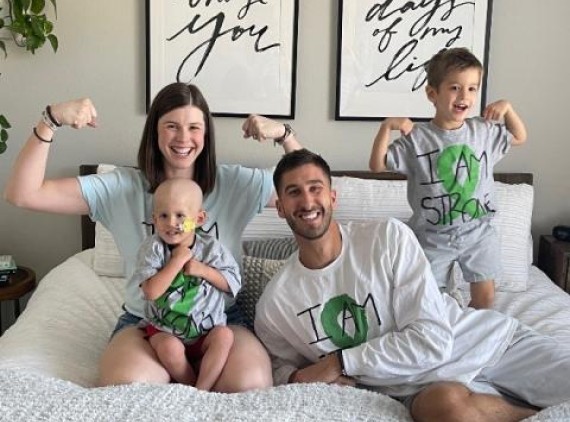Nash is strong. Just ask him, and he’ll flex his arm muscles and give you a big grin. He’ll even show you his belly scar, where just a few months ago, he had a liver transplant (now called his “happy liver”).
During a seven-month stretch in 2022, Nash spent over 130 nights at Phoenix Children’s. He went through a cancer diagnosis, chemotherapy, liver surgery and a liver transplant – all before he turned 3 years old.
The lump that was liver cancer
It all started on Good Friday when, during a routine diaper change, Nash’s parents noticed a lump in his stomach. They visited their pediatrician right away. Because it was a holiday weekend, they were referred to Phoenix Children’s. They headed straight to the emergency department. At the time, they weren’t too concerned – they thought it was constipation, and once Nash had a bowel movement, the lump would go away. They were even planning to host family at their house later that weekend for Easter.
Unfortunately, the lump didn’t go away. What they thought would be an in-and-out visit turned into 48 hours of tests and exams. Nash had an X-ray, ultrasound, electrocardiogram (EKG), echocardiogram, CT scan, MRI, hearing test and a biopsy. Finally, Nash’s parents received the shocking diagnosis: their son had hepatoblastoma, liver cancer. About 75% of Nash’s liver was covered in tumors.

Nash’s family didn’t have much time to process the information. They had to act right away and get him started with treatment. They also didn’t know how long they would be at Phoenix Children’s. Another challenge was that Nash’s brother, Knox, wasn’t allowed in his room due to COVID-19 protocols. Thankfully, Child Life staff provided supplies, so the family could put a poster in their window. That way, Knox would know where his brother’s room was from the hospital lawn.
The family chose to write “I am strong” on the poster, inspired by the Joshua 1:9 Bible verse: “This is my command – Be strong and courageous! Do not be afraid or discouraged. For the Lord your God is with you wherever you go.”
“We decided to be strong, even when we didn’t understand what was going on and why this was happening,” said Nash’s mom, Kendyll. “Even when we didn’t know what the outcome was, we knew we needed to root ourselves in faith and believe that we’ve got this.”
The “I am strong” poster went with Nash for every stay at Phoenix Children’s, including that Tuesday, when he got his first round of chemotherapy. Nash’s parents knew upfront that he would have to do at least six rounds of chemo. They also had the option to try liver surgery or find a liver for a liver transplant.
“After a few rounds of chemo, we decided to do the liver resection surgery,” shared Kendyll. “A transplant is a lifelong change, so we wanted to give Nash the opportunity to keep his own liver.”
They worked with Ramin Jamshidi, MD, who attempted the liver resection to remove the tumors from Nash’s liver. The plan was to do a partial resection, getting rid of the cancerous area and leaving Nash with only 40% of his liver. The liver is amazing because of its ability to regenerate.
“We knew it was a possibility that the surgery wouldn’t work,” said Kendyll. “Dr. Jamshidi was very upfront with us. After about five hours into the surgery, he came out, and we said, ‘You’re closing him up, aren’t you?’ One of the tumors was too close to the blood vessel to remove it.”
The search for a new liver
With surgery no longer being an option, Nash’s family shifted their focus to finding a liver for a liver transplant. The team at Phoenix Children’s wanted Nash to get a liver as soon as possible. The family started the process of getting Nash evaluated, approved and then placed on the transplant waiting list.
Nash was on the transplant wait list by Aug. 1, 2022. His status was 1B, which is very high on the list to receive a liver transplant. After getting on the list, all Nash’s family could do was wait until a liver became available. His mom described the entire process as a roller coaster.
“The liver Nash ended up receiving was his third offer,” Kendyll shared. “They warn you ahead of time that they might bring you in [for a liver] and then have to send you back home. You just don’t know how that’s going to feel until you’re in the moment, and you’re living it.”
The first attempt
With the first liver offer, Kendyll remembered getting the call while they were already at Phoenix Children’s. Nash was doing maintenance chemotherapy so his liver tumors wouldn’t grow back. The plan was to continue chemo until he got a liver transplant. A member of the transplant team called Kendyll to say there might be a liver for Nash in 12 hours.
A successful liver transplant depends on many factors, including the recipient, the donor and the timing. There’s a short timeframe from when the donor liver can be taken and when it can be transplanted. The recipient also must have healthy blood and platelet levels.
Nash was scheduled to get the liver at 10 p.m. At 9:30 p.m., his family got the call that timing wouldn’t work out with the donor.
The second try
By October, Nash still hadn’t received a liver, so his family went to Los Angeles to try to get dual-listed at Children’s Hospital Los Angeles. They hoped that being on multiple lists would mean getting a liver sooner. Kendyll got the call for the second offer while the family was in Los Angeles. Within an hour, they got two calls – one saying there might be a liver for Nash, and another saying that the liver was a no-go. Test results from the liver had come back, and one of them wasn’t in Nash’s favor.
“That in and of itself [causes] a range of emotions,” reflected Kendyll. “You’re excited and anxious, and you’re all these ups and downs.”
Match made
When the third offer came, Kendyll wasn’t as confident it would work out.
“They called us right after we had gotten home from Nash’s morning chemo,” she remembered. “They said, ‘We have a liver for you,’ and I said, ‘Sure, OK. We’ll see you when we see you,’ but I could tell it was urgent, and they thought that this was the one.”
The family got to Phoenix Children’s on Nov. 2 at 4 p.m. After that, all they could do was wait. Transplants can take anywhere from five to 12 hours. Nash’s took about eight hours. He successfully received his transplant by 3 a.m. on Nov. 3.
A transplant success

Nash was in the Pediatric Intensive Care Unit (PICU) for a few days, then moved to another floor for further recovery. He stayed at Phoenix Children’s for about a month.
“I told Nash when we went in at the beginning of November, ‘We’ve got to be out for Thanksgiving,’” Kendyll remembered, “and he got out just before Thanksgiving. He was actually a quick transplant baby as far as hospitalization because some kiddos are there for much longer than our family.”
Since the transplant, Kendyll has noticed a big difference in Nash, especially his color. He lost a lot of color in his face because of the chemo and often looked worn out and tired. Now, he has life again. He has energy and joy.
“Before, he was always so stoic,” Kendyll said. “He ate, and he played, but nothing brought him joy. His big brother, Knox, is the opposite, and we always wondered how that could be. I don’t think we realized how sick Nash was.”
Gratitude and the importance of organ donation

With organ transplants, donor information is kept confidential. After one year, the recipient family can opt into communicating with the donor family if both parties approve. For now, Nash’s family doesn’t know anything about the donor, except that the family was located within a 500-mile radius of Phoenix Children’s.
“We would love to meet them in person and give them a hug,” said Kendyll. “We know that they lost their kid for ours to have life. We’re just so thankful that we got to be the recipient.”
She also recognizes that it can be hard to make the decision for a child to be an organ donor. For pediatrics especially, most families have gone through trauma. Many don’t talk about organ donation because they’re not planning for their child to be gone.
“The conversation is probably happening when parents are in shock and in the midst of their trauma,” reflected Kendyll, “but organ donation at any age is such a blessing to the family who receives it. It’s a very humbling experience because we literally can never repay that family. You just have to receive it and be thankful for it and cherish it.”
Kendyll knows that Nash’s healthcare journey isn’t over. He may have to deal with organ rejection or other issues. For now, though, Nash is happy, and his liver is happy. On Jan. 17, 2023, he rang the bell at Phoenix Children’s for being cancer free (and retired the “I am strong” poster).
“We’ve been so blessed by our experience,” shared Kendyll. “It was horrendous going through it, but at least we were surrounded by amazing people. That’s what got us through, honestly. The Phoenix Children’s team is so incredible. They hold you up on your days of weakness, when you’re tired as a parent or confused. They’re just amazing.”

